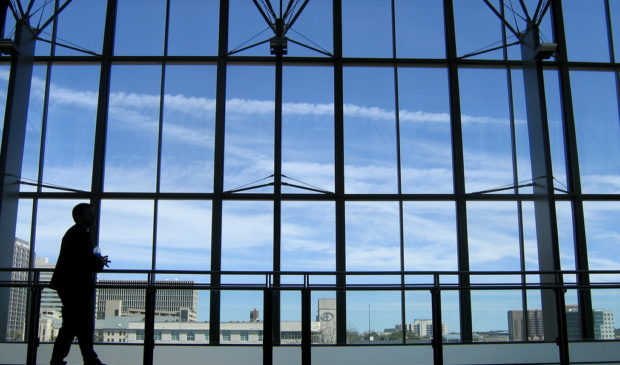About the Author
Chad Swiatecki is a 20-year journalist who relocated to Austin from his home state of Michigan in 2008. He most enjoys covering the intersection of arts, business and local/state politics. He has written for Rolling Stone, Spin, New York Daily News, Texas Monthly, Austin American-Statesman and many other regional and national outlets.
-

Newsletter Signup
The Austin Monitor thanks its sponsors. Become one.
Most Popular Stories
- New federal cash paves way for East Austin’s ‘wishbone’ bridge over Lady Bird Lake
- Austin’s airport is getting a new concourse and 20 more gates but not until the 2030s
- Judge rules city can’t use taxpayer money for South Central TIRZ
- Save Our Springs Alliance sues City Council over Open Meetings Act
- Democrats vs. Republicans: First election coming for Travis Central Appraisal District board
-
Discover News By District

Tourism Commission backs 2017 findings pushing convention center expansion
Monday, May 20, 2019 by Chad Swiatecki
Signaling more possible momentum for a push to expand the Austin Convention Center, the city’s Tourism Commission has recommended City Council adopt a 2017 report outlining the benefits and possible frameworks for the project.
At last week’s meeting, the commission voted unanimously – with new member Brian Rodgers abstaining – to ask Council to implement the findings of the Visitor Impact Task Force, which spent four months researching the then-initial proposal to expand the convention center using funding from a 2 percentage point increase in the city’s Hotel Occupancy Tax levy on guest room nights.
The commission’s vote was the first action taken following the release in late March of a long-awaited study by the University of Texas on possible scenarios for the expansion. That report showed how a westward expansion using most of three blocks of property could drastically reconfigure the facility with ground floor retail and cultural uses and a variety of parklike gathering spaces.
The cost of those scenarios range from over $400 million to more than $1 billion, with bond sales backed by HOT revenue and public-private partnerships among the funding sources.
James Russell, the chair of the 2017 task force, said the UT study reflects the goals of his group and could result in a more modern, open space in a portion of downtown that was seen by the architectural analysis as the unintended focal point of four different development “vectors.”
“What we wanted with the convention center was something that would repair the downtown framework, make it an accessible part of the downtown ecosystem and not the shoebox that we currently have,” he said. “If we’re going to expand the convention center for any reason it needs to be done in a thoughtful way and not in a 1992 way.”
Prior to the vote, Commissioner John Riedie asked if the recommendation should also reference the upcoming Council resolution regarding Palm School, which is adjacent to the convention center and is growing in prominence as a bargaining point in the future development of the southeastern portion of downtown. That suggestion was turned down because the VITF report was more specific for the convention center and the overall focus of the Tourism Commission.
The release of the UT study has been followed by discussion at various boards and commissions over how big of a need there is to expand the center, and how much of an impact the facility has on local hotel business.
Joe Bolash, chairman of Austin Hotel & Lodging Association, said while industry data show 3 percent of area hotel business is tied to meetings and conventions, that figure is far higher for the hotels currently opened or planned for downtown near the convention center.
“When you look at Austin from the view of a hotelier, what you see is this beating heart in the form of the convention center, and that compresses demand through the rest of the city,” he said. “When you look at how robust our (average daily rates) are – and they’re some of the best and strongest in the state – it’s really driven by the rate that we can demand, and that rate is a ratio on whether or not the convention center is full.”
Rodgers, who works in the commercial real estate investment field, questioned how much demand for ground floor retail space there could be in the various expansion scenarios, and pointed out that estimates on tax rates for commercial use of the proposed expansion sites tend to disregard the tax revenues generated for local schools and other taxing districts.
He also said he and other city leaders should be shown more data on the state of the national convention industry so they can be sure there is sufficient demand to keep a larger convention center filled with business instead of sitting empty.
“Before I would go out and spend $900 million on an expansion I would really want to know what is the growth of the convention center business in the United States,” he said. “(Cities) start robbing each other for their tenants, the same thing we do in the commercial real estate business. How can we get more secure in the low, medium and high number?”
Photo by Thor Muller, from Flickr. Made available by a Creative Commons License.
The Austin Monitor’s work is made possible by donations from the community. Though our reporting covers donors from time to time, we are careful to keep business and editorial efforts separate while maintaining transparency. A complete list of donors is available here, and our code of ethics is explained here.
You're a community leader
And we’re honored you look to us for serious, in-depth news. You know a strong community needs local and dedicated watchdog reporting. We’re here for you and that won’t change. Now will you take the powerful next step and support our nonprofit news organization?









